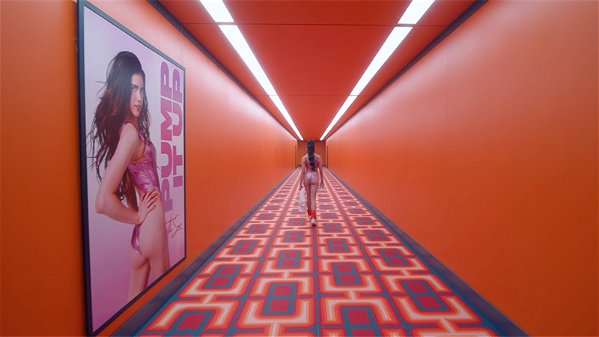By Edward Bayliss
Someone at some point said something about good artists borrowing and great artists stealing. The provenance of this quotation is unclear, the meaning perhaps even more so. All art must have some kind of singularity as well as a worldliness, that is, both originality and inspiration. I’m interested in how art, or in this case the new cinema release The Substance, approaches its inspirations and predecessors. The question I suppose, is whether this film steals – makes its own, and bends these images and threads of plot to its will? Otherwise, does it only borrow, pedestal and ultimately return untouched and unexplored its horror inheritance? I’m afraid to say that Coralie Fargeat’s The Substance reads more like maniacal fan mail than a love letter to its genre’s history.
The issue is that the film loses almost all shreds of singularity to a screenplay swamped with incoherent horror recollections dropped with exhausting frequency. Like the Hitchcock cameos in his early films, we find ourselves constantly on the lookout for his next appearance, or in this case, for the next Kubrick corridor, or bathroom for that matter. We’re full on easter eggs, thank you very much director Coralie Fargeat. Here we have homage for the sole sake of homage, a mere gesture of tokenistic exchange. What I want to see is theft; for Fargeat to take these images and make them her own, to possess them.
I made a mental list of all the films that The Substance referenced while watching it in the cinema. I didn’t want to, but these allusions were too often so painfully blatant that I couldn’t help myself. As the run-time wears on, the film becomes less like a window, and more like a mirror. It reflected scenes, sounds and ideas from: Black Swan, Carrie, Requiem for a Dream, American Psycho, The Shining, 2OO1: A Space Odyssey, The Fly, Men, The Great Gatsby, Vertigo, The Elephant Man, and Brazil. Plotwise, it riffs heavily on Oscar Wilde’s The Picture of Dorian Gray. Much of these representations exist very strikingly in their isolated forms. The extreme close up shots of dilated eyes and gunk filled syringes of Requiem for a Dream; the gross body horrors of The Fly, The Elephant Man and Men; the dystopian and sickly unrealism of Brazil; the bloody theatricality of Carrie and American Psycho; the restless score of Vertigo. All of these are brilliant constructions of cinema, but they rub awkwardly against each other in The Substance. There’s no cohesion to this collective as they each, it seems, vie for their spot in the limelight. It feels as though we are thumbing our way through a tired catalogue, whose pages we’ve read before and will read again. It’s bad borrowing.
It should be said, Carolie Fargeat’s film is very good looking. She opts to shoot in 2.39:1 aspect ratio, or ‘anamorphic widescreen format’ for the terminologists amongst us. This is pretty much the widest modern cinema format available, used traditionally to capture broad landscapes in period dramas or sprawling universes in sci-fi films. Here though, we have an insanely wide frame used in compact corporate interiors, affording an uncomfortably full and stuffy feel to the shot. It’s just a shame that the director feels the need to fill the frame with objects and ideas that aren’t hers – a fact of dispossession we notice too often. Unlike The Cabin in the Woods, which fondly and friskily recollects its horror inheritance, or The Witch, whose woodland setting riffs convincingly on recent and ancient folkloric tropes, The Substance’s references are woefully soulless. Fargeat seems to think that any given image from a film will translate seamlessly into hers, and this misunderstanding is what characterises the bad borrowing of the director.
There are some shards of hope. The crosshairs of this piece have landed only on the referential aspect of Fargeat’s film. There are many qualities to this film; though whether they are redeeming I’m not sure. This will seem a footnote to the article, but I’ll say that the superb performances of Margaret Qualley, and, especially, Demi Moore didn’t go unnoticed. I also respect the fact that Fargeat remained unafraid to attack the potent and pressing issue of body image with a biting relevance. It’s just a shame that our attention is dragged towards half-baked horror allusions and not the features I mention latterly.

